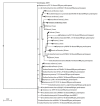Khat Chewing Induces a Floral Shift in Dental Material-Associated Microbiota: A Preliminary Study
- PMID: 31956260
- PMCID: PMC6990665
- DOI: 10.12659/MSM.918219
Khat Chewing Induces a Floral Shift in Dental Material-Associated Microbiota: A Preliminary Study
Abstract
BACKGROUND The habit of khat (Catha Edulis Forskal) chewing is widely practiced in the southern regions of Saudi Arabia, Yemen, and East Africa. This social habit has tremendous effects on oral and general health of khat chewers. Khat may affect bacterial species in plaque biofilms on oral rehabilitation materials. This preliminary case-controlled study aimed to assess and compare the effect of khat chewing on bacterial biodiversity between non-khat chewers (NKC) and khat chewers (KC) in oral biofilms on oral rehabilitation materials using polymerase chain reaction (PCR). MATERIAL AND METHODS Fifty participants were organized into 2 equal groups of NKC and KC, each containing 5 subgroups related to filling material type. Some participants had amalgam (A) or composite (C) restorations, while others had feldspathic porcelain (FP), nickel chromium (NC), and zirconia ceramic (ZC) crowns or bridges. Oral biofilm samples were collected from all participants, DNA was extracted, and samples were subjected to PCR. Bacterial species were then identified and counted. PCR products were sequenced to detect similarity. Partial 16S rRNA gene sequences of the current study samples were compared with 16S rRNA gene sequences from GenBank using BLAST on the National Center for Biotechnology Information website. RESULTS The Streptococcus sp. was the most common bacterial species among our participants (40; 80%), followed by Lactobacillus and Veillonella spp., accounting for 12% (6) and 8% (4), respectively. Streptococcus sp. was observed equally among NKC and KC, but Lactobacillus and Veillonella spp. were higher in KC and NKC, respectively. Lactobacillus was associated mainly with prosthetic materials, and Streptococcus was found among all examined dental restorative materials. CONCLUSIONS This research concluded that khat chewing significantly affects bacterial biodiversity in oral biofilms in the presence of different restorative and prosthetic dental materials.
Conflict of interest statement
None.
Figures

Similar articles
-
Oral Biofilm on Dental Materials Among Khat Chewers.Curr Pharm Biotechnol. 2020;21(10):964-972. doi: 10.2174/1389201021666200121142300. Curr Pharm Biotechnol. 2020. PMID: 31965942
-
Effect of khat chewing on 14 selected periodontal bacteria in sub- and supragingival plaque of a young male population.Oral Microbiol Immunol. 2005 Jun;20(3):141-6. doi: 10.1111/j.1399-302X.2004.00195.x. Oral Microbiol Immunol. 2005. PMID: 15836514
-
Khat chewing and smoking effect on oral mucosa: a clinical study.Acta Medica (Hradec Kralove). 2009;52(4):155-8. doi: 10.14712/18059694.2016.122. Acta Medica (Hradec Kralove). 2009. PMID: 20369709
-
Khat (Catha edulis) and its oral health effects: An updated review.J Investig Clin Dent. 2018 Feb;9(1). doi: 10.1111/jicd.12288. Epub 2017 Aug 19. J Investig Clin Dent. 2018. PMID: 28834423 Review.
-
Khat (Catha edulis): health aspects of khat chewing.East Mediterr Health J. 2007 May-Jun;13(3):706-18. East Mediterr Health J. 2007. PMID: 17687845 Review.
Cited by
-
Microbiome Studies from Saudi Arabia over the Last 10 Years: Achievements, Gaps, and Future Directions.Microorganisms. 2021 Sep 24;9(10):2021. doi: 10.3390/microorganisms9102021. Microorganisms. 2021. PMID: 34683342 Free PMC article. Review.
-
Effects of Khat on Surface Roughness and Color of Feldspathic and Zirconia Porcelain Materials under Simulated Oral Cavity Conditions.Medicina (Kaunas). 2020 May 13;56(5):234. doi: 10.3390/medicina56050234. Medicina (Kaunas). 2020. PMID: 32414190 Free PMC article.
-
Optimizing the quality of clinical studies on oral microbiome: A practical guide for planning, performing, and reporting.Periodontol 2000. 2021 Feb;85(1):210-236. doi: 10.1111/prd.12359. Epub 2020 Nov 23. Periodontol 2000. 2021. PMID: 33226702 Free PMC article. Review.
-
Assessment of Color Stainability of Computer-Aided Design and Computer-Aided Manufacturing (CAD/CAM) Ceramic Materials After Hot and Cold Coffee Immersion at Different Time Intervals.Med Sci Monit. 2021 Oct 3;27:e932745. doi: 10.12659/MSM.932745. Med Sci Monit. 2021. PMID: 34601487 Free PMC article.
References
-
- Lea SC, Landini G, Walmsley AD. A novel method for the evaluation of powered toothbrush oscillation characteristics. Am J Dent. 2004;17(5):307–9. - PubMed
-
- Flemming HC, Wingender J. The biofilm matrix. Nat Rev Microbiol. 2010;8(9):623–33. - PubMed
-
- Caglar E, Kargul B, Tanboga I. Bacteriotherapy and probiotics’ role on oral health. Oral Dis. 2005;11(3):131–37. - PubMed
MeSH terms
Substances
LinkOut - more resources
Full Text Sources
Research Materials
Miscellaneous

